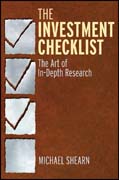
A practical guide to making more informed investment decisions Investors often buy or sell stocks too quickly. When you base your purchase decisions on isolated facts and don't take the time to thoroughly understand the businesses you are buying, stock-price swings and third-party opinion can lead to costly investment mistakes. Your decision making at this point becomes dangerous because it is dominated by emotions. The Investment Checklist has been designed to help you develop an in-depth research process, from generating and researching investment ideas to assessing the quality of a business and its management team. The purpose of The Investment Checklist is to help you implement a principled investing strategy through a series of checklists. In it, a thorough and comprehensive research process is made simpler through the use of straightforward checklists that will allow you to identify quality investment opportunities.Each chapter contains detailed demonstrations of how and where to find the information necessary to answer fundamental questions about investment opportunities. Real-world examples of how investment managers and CEOs apply these universal principles are also included and help bring the concepts to life. These checklists will help you consider a fuller range of possibilities in your investment strategy, enhance your ability to value your investments by giving you a holistic view of the business and each of its moving parts, identify the risks you are taking, and much more. Offers valuable insights into one of the most important aspects of successful investing, in-depth research Written in an accessible style that allows aspiring investors to easily understand and apply the concepts covered Discusses how to think through your investment decisions more carefully With The Investment Checklist, you'll quickly be able to ascertain how well you understand your investments by the questions you are able to answer, or not answer, without making the costly mistakes that usually hinder other investors. INDICE: Preface. Chapter 1: How to Generate Investment Ideas. How Investing Opportunities Are Created. How to Filter Your Investment Ideas. Using a Spreadsheet to Track Potential and Existing Holdings. Chapter 2: Understanding theBusinessThe Basics. 1. Do I want to spend a lot of time learning about this business? 2. How would you evaluate this business if you were to become its CEO? 3. Can you describe how the business operates, in your own words? 4. How does the business make money? 5. How has the business evolved over time? 6. In what foreign markets does the business operate, and what are the risks of operating in these countries? Chapter 3: Understanding the Businessfrom the CustomerPerspective. 7. Who is the core customer of the business? 8. Is the customer base concentrated or diversified? 9. Is it easy or difficult to convince customers to buy the products or services? 10. What is the customer retention rate for the business? 11. What are the signs a business is customer oriented? 12. What pain does the business alleviate for the customer? 13. To what degree is the customer dependent on the products or services from the business? 14. If the business disappeared tomorrow, what impact would this have on the customer base? Chapter 4: Evaluating the Strengths and Weaknesses of a Business and Industry. 15. Does the business have a sustainable competitive advantage and whatis its source? 16. Does the business possess the ability to raise prices without losing customers? 17. Does the business operate in a good or bad industry?18. How has the industry evolved over time? 19. What is the competitive landscape, and how intense is the competition? 20. What type of relationship does the business have with its suppliers? Chapter 5: Measuring the Operating and Financial Health of the Business. 21. What are the fundamentals of the business?22. What are the operating metrics of the business that you need to monitor? 23. What are the key risks the business faces? 24. How does inflation affect the business? 25. Is the business's balance sheet strong or weak? 26. What is the Return on Invested Capital for the Business (ROIC)? Chapter 6: Evaluating the Distribution of Earnings (Cash Flows). 27. Are the accounting standards that management uses conservative or liberal? 28. Does the business generate revenues that are recurring or from one-off transactions? 29. To what degree is the business cyclical, countercyclical, or recession-resistant? 30. To what degree does operating leverage impact the earnings of the business? 31. How does working capital impact the cash flows of the business? 32. Does the business have high or low capital expenditure requirements? Chapter 7: Assessing the Quality of ManagementBackground and Classification: Who Are They? 33. What type ofmanager is leading the company? 34. What are the effects on the business of bringing in outside management? 35. Is the CEO a lion or a hyena? 36. How did the manager rise to lead the business? 37. How
- ISBN: 978-0-470-89185-8
- Editorial: John Wiley & Sons
- Encuadernacion: Cartoné
- Páginas: 384
- Fecha Publicación: 19/10/2011
- Nº Volúmenes: 1
- Idioma: Inglés
